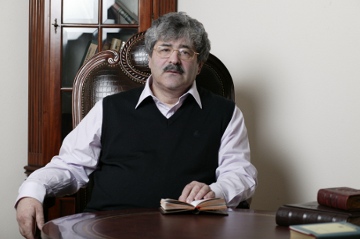
“It is the day of resurrection! Let us be illumined for the feast!” - even the air in the church seems to vibrate with joy when the Easter chant sounds during the celebration of the feast of feasts. A week before the resurrection, Jesus told Mary, the sister of Lazarus: “Your brother will rise again” and she replied with firm belief that “he will rise again in the resurrection at the last day”, that is, at the final moment of the earthly history. “I am the resurrection and the life” (John 11:25) said Jesus to make it clear that Lazarus would be restored to life right at the time, as would be restored to life the souls of Mary and whoever witnessed the miracle. What appeared to be distant thus became immediate reality, and the resurrection of all on the last day grew as obvious as an established fact despite the ages that lay ahead. In our days, Easter similarly shines the light of the promised joy on our existence.
The words of St. John Chrysostom, the eloquent Archbishop of Constantinople and a great theologian who died in exile 407 on the territory of today's Abkhazia, are read during every Easter liturgy: “Let no one fear death, for the Death of our Savior has set us free”. His “O death, where is thy sting? O Hades, where is thy victory? Christ is Risen, and you, O death, are annihilated! Christ is Risen, and the evil ones are cast down! Christ is Risen, and the angels rejoice! Christ is Risen, and life is liberated! Christ is Risen, and the tomb is emptied of its dead” hardly leave anyone untouched.
Given the precious gift of free choice, an individual also has perverted freedom to close his heart for God, but insulating the history of humanity from God – the evil mission Judas attempted to accomplish for a payment of thirty silver coins - is impossible. The rising secularity, sophisticated or crude, will similarly fail, and the impression during every Easter service is that mankind as a whole, not just the thousands of believers who gather in churches to celebrate, is facing God.
One might wonder why the coming resurrection of all the dead is a reason to rejoice if the Final Judgment Day follows. The question combines an element of adequacy with polemic thrust. Importantly, we are a long way from that remote destination and still have time for repentance, but the time will run out when we get there, as several saints explained. St. Gregory of Nyssa, a prominent Father of the Church, pinpointed the difference between now and then by saying that Easter is in a way a happier day than that of the Second Coming of Christ as there is still hope for sinners to earn forgiveness through penance, and therefore everybody without exception rejoices, while those eventually found to be sinners will weep bitterly when God pronounces the final judgment.
The above should make it clear why Lent, particularly its last week, are to be dedicated to penance. Those who neglected to stride this path of personal repentance have no chance of reaching the eternal life.
I did hear on various occasions and from quite a few present-day Svidrigailovs that “O death, where is thy sting?” is too much ado for our epoch with its petty ills, squabbles, and characters who simply do not merit punishment in Gehenna or Tartarus. Do the Biblical invectives about the hell where "the worms that eat them do not die, and the fire is not quenched” (Mark 9:48) really apply to the world as we know it? A fairly well-known author, with her college credentials intact and even a trace of talent, dished out a passage that, maybe, even Dostoevsky would not have overlooked: “Accounts of neoteny – reproduction of organisms commencing already in the larval phase, before maturity is reached - are easy to come across in zoology. The organisms may never mature due to lack of some pertinent factors in the environment, and whole populations of larvae arise – we live in a larvae society composed of adolescents in the guises of adults”. Wonderful, isn't it?
The Svidrigailov-style trick in the above is not deeply hidden despite the aggressive packaging. The human degradation into the larva state is attributed to the lack of some factors in the environment, to a negative impact of purely external circumstances. The actual triggers, though - in the cases of the fall and the revival - are always found inside: “the kingdom of God is within you” (Luke 17:20-21). Shutting it out quickly switches a human to the larval condition, but the responsibility for the transformation rests with the individual.
<!--[if gte mso 9]> <!--[if gte mso 9]> Normal 0 false false false RU JA X-NONE <!--[if gte mso 9]> <!--[if gte mso 10]> /* Style Definitions */ table.MsoNormalTable {mso-style-name:"Обычная таблица"; mso-tstyle-rowband-size:0; mso-tstyle-colband-size:0; mso-style-noshow:yes; mso-style-priority:99; mso-style-parent:""; mso-padding-alt:0cm 5.4pt 0cm 5.4pt; mso-para-margin:0cm; mso-para-margin-bottom:.0001pt; mso-pagination:widow-orphan; font-size:10.0pt; font-family:"Times New Roman";} <!--StartFragment--> The circumstances which confronted the fishermen-turned-apostles before the global spread of the historical Christianity appeared to render their preaching totally impractical. The Resurrection of Christ did resonate, but not as some sort of a “historical” shift - it was an event which uniquely enlightened human souls. By all means, those whom Christ came to lead to salvation were not larvae – as Apostle Paul made it clear, Christ was saving the imperishable beauty of the inner man made in God's image and after God's likeness. One of the Fathers of the Church, IV century theologian and poet Ephrem the Syrian warned that God does not allow offense to his own image, in man in particular, and avenges any attempts to inflict it. The Holy Resurrection is how God punished the devil for defiling God's image in humans – and from this we draw hope for the resurrection of our souls. <!--EndFragment-->
read more in our Telegram-channel https://t.me/The_International_Affairs

 14:20 28.04.2011 •
14:20 28.04.2011 •






















